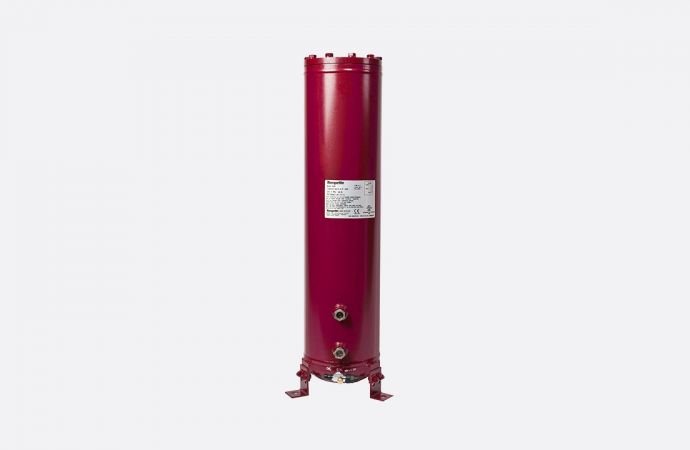Inefficient oil separation will leave a film on the heat exchanger surfaces and decrease system efficiency, explains Emerson/Temprite report.

The 928R coalescent oil separator from Temprite.
Replacing conventional oil separators with coalescing (coalescent) units can save retailers both energy and money, according to a report by U.S. component manufacturer Emerson Climate Technologies, and shared by Temprite.
Temprite, based in West Chicago, Illinois, manufactures oil management components for the cooling industry, including conventional and coalescing oil separators and other oil management products suitable for hydrocarbon, ammonia/NH3 (R717) and CO2 (R744) refrigeration systems.
There are several types of oil separator technologies used in refrigeration, but all aim to prevent excessive oil circulation in the system. They do this by isolating the oil early in the discharge line and returning it to the compressor.
The oil’s purpose is to lubricate the compressor, but if the separation isn’t efficient enough, oil will circulate in the entire system — resulting in the build up of an oily film on the surfaces of heat exchangers. This film will act as an insulator preventing efficient heat exchange, thus lowering system efficiency and consequently increasing energy consumption.
Coalescing oil separators’ advantages
Well-designed coalescing oil separators can remove 95 to 99% of the mass-flow oil component. They do this by utilizing a filter medium made of pure glass fibers; this is capable of removing even the tiniest oil molecules by forcing them to collide and form droplets large enough to be routed by gravity through a drain layer.
A controlled test – carried out by Russell Cooper of Emerson Climate Technologies, author of the report – looked at the efficiency of different separator technologies, and the coalescing unit was by far the most efficient.
“While competing separator types were able to reduce the percent of oil circulating by upwards of 87%, the coalescing design went further, reducing the amount by over 99% from the no-separator baseline environment," Cooper explained. “The rationale for improved energy efficiency is therefore present.”
In addition to this, coalescing separators can maintain the same level of effectiveness down to almost 20% of the separator’s rated load. “This is increasingly important as more stores employ refrigeration load shifting/matching to reduce energy consumption,” Cooper wrote in his report of the tests. “Rival centrifugal designs do not share this ability, and their efficiency drops as load does.”
In the test setup, the coalescent oil separator needed 1.550kW of energy/TR (0.442kW/kW) of refrigeration, whereas a centrifugal separator needed 1.561kW/TR (0.446kW/kW). “Even with these incremental improvements, it is very possible to make significant reductions in energy costs,” Cooper stressed, noting that with larger refrigeration loads comes the greatest potential for savings.
In a theoretical example with a mid-sized store, assuming electricity prices set at the U.S. average, using coalescing oil separators instead of “conventional” types could amount to yearly energy savings of US$1,752 per store, the report says.
“The first cost investment for this approach could be as little as $500 per store, Cooper wrote. “That’s an attractive return on investment for almost any business.”
Additional benefits of coalescing oil separators are a reduction of the required oil volume, reduced start-up time, reduced oil slugging, and elimination of solid contaminants in the system.
Download Cooper’s report from Temprite’s website here.
On its website, Temprite also offers a “cost-saving calculator” that allows customers to determine how much energy costs can be reduced with Temprite’s series 920 or 920R coalescing oil separators, suitable for hydrocarbons, ammonia or subcritical CO2 systems.
While competing separator types were able to reduce the percent of oil circulating by upwards of 87%, the coalescing design went further, reducing the amount by over 99% from the no-separator baseline environment," - Russell Cooper, Emerson
Want to find out more, or have something to say about this story? Join the ATMO Connect network to meet and engage with like-minded stakeholders in the clean cooling and natural refrigerant arena.
Related stories




